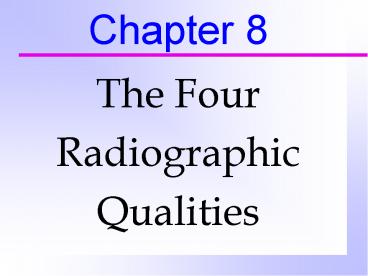The Four PowerPoint PPT Presentation
Title: The Four
1
Chapter 8
- The Four
- Radiographic
- Qualities
2
Radiographic Qualities
- There are four distinct qualities in a radiograph
that determines the overall quality of the film. - They are
- Detail
- Density
- Contrast
- Distortion
3
Detail
- Detail is the delineation or demarcation that
separates one structure, organ or tissue from
another. The size of the focal spot plays a large
part in the amount of detail seen on film.
Penumbra is the blurring of the edges of an
object due to the size of the focal spot.
4
Detail
- Primary Factor
- Detail is primarily controlled by the size of the
focal spot. The larger the focal spot, the poorer
the detail the smaller the focal spot, the
better the detail, again, due to the penumbra
effect.
5
Detail
- Secondary Factors
- FAD
- PFD
- Improper Kv
- (High Kv Grey film)
- (Low Kv Black/White film)
- FAD and PFD are concerned with distortion but the
greater the distortion, the poorer the detail.
6
Density (MAS)
- Density (MAS) is responsible for the blackening
effect on your film and refers to the amount of
light that will pass through the film when it is
held before a viewing box. The amount of density
is directly proportional to the percentage of
blacks and grays as compared to whites.
7
Density (MAS)
- The greater the percentage of blacks and grays
the greater the density of your film. If the
white areas are excessive, density would be
considered minimal. Proper density suggests just
the right proportion of blacks, whites and grays
for the area being radiographed. With proper
density one would expect to see all the areas of
the film adequately.
8
Density (MAS)
- Primary Factor
- Density is primarily controlled by the
milliampere-seconds. The greater the MAS, the
greater the density the lower the MAS, the less
dense the film.
9
Density (MAS)
- Secondary Factors
- Exposure of the film to scattered rays or light
- Exposure of the film to fumes, heat or moisture
- Improper FAD. When the distance is changed and
MAS is not taken into account the density will be
incorrect. - Developing Mistakes
- Improper KV.
10
Contrast (Kv)
- Contrast (KV) refers to the differences between
the black, white and gray shadows that might be
represented on a radiograph. - Excessive contrast suggests that the shadows will
be black and white and little gray (short scale
contrast).
11
Contrast (Kv)
- Minimal contrast suggests that the shadows will
be mostly gray with little black or white areas
(Long scale contrast). With proper contrast there
is proper distribution of these three shadows.
12
Contrast (Kv)
- Main Factor
- Contrast is primarily controlled by the
kilovoltage since it is the kilovoltage which
controls the penetrating power of the x-ray beam,
that is , what portions of the film will be
white, what portions gray, what portions black.
With black shadows there has been complete
penetration, with gray shadows some penetration
and with white shadows no penetration.
13
Contrast (Kv)
- The higher the KV, the lower the contrast (less
difference in adjacent densities) the lower the
KV, the higher the contrast. Remember that higher
the kV the more Comptons scattering. This
scatter, which occurs at the higher energy
levels, will be strong enough to make its way
onto the film. This is why higher kV levels often
result in grayer film.
14
Contrast (Kv)
- Less important factors that may effect contrast
- Exposure of film to scattered rays or light
- Exposure of film to fumes, heat or moisture
- Outdated film
- Improper FAD or Improper MAS
- Developing Mistakes
- Film emulsion characteristics
- Contrast is increased by the use of cassettes
rather than cardboard holders
15
Distortion
- Distortion is the misrepresentation of an
anatomical structure on a radiograph. It cannot
be completely avoided, but it can be minimized.
To minimize distortion, use a close PFD and a
long FAD.
16
Distortion
- Main Factors
- Distortion is primarily controlled by the
film-anode distance. The greater the FAD, the
less the distortion the shorter the FAD, the
greater the distortion. - Another important factor is PFD.
17
Distortion
- Less important factors that may effect contrast
- Improper positioning
- Angulation of the x-ray beam.
- Focal spot size due to magnification

